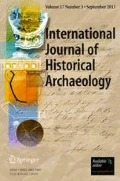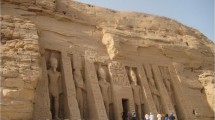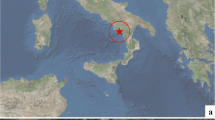Abstract
The Melbourne branch of the Royal Mint officially opened in 1872. Built on a site that had previously accommodated Melbourne’s original Exhibition Hall, the complex comprised the extant Administration Building and flanking Guardhouses and substantial “operative departments” to the rear. The latter were demolished in the early 1970s but recent investigations have revealed that substantial remains survive. This paper discusses our new appreciation of the Mint’s archaeology – one of an increasing number of Melbourne archaeological sites where subsurface deposits are supplementing our knowledge of places long acknowledged for the importance of their built heritage. The remains reveal important evidence relating to the minting process and responses to industrial urban air pollution in the nineteenth century.


















Similar content being viewed by others
References
Andronas Conservation Architecture (2013). Conservation Management Plan Review: The Former Royal Mint Site, 280 William Street, Melbourne, Report for The Mint, Melbourne.
Brimblecombe, P. (2004). Perceptions and effects of late Victorian air pollution. In DuPuis, E. M. (ed.), Smoke and Mirrors: The Politics and Culture of Air Pollution, New York University Press, New York, pp. 3–26.
Broom, R., Barnden, R., Gibb, D., Jackson, E., and Smart, J. (2016). Remembering Melbourne 1850–1960, Royal Historical Society of Victoria, Melbourne.
Burritt, P. (1981). Historical Archaeology at the Royal Mint and the Hyde Park Barracks, Report to Heritage Council and Public Works Department of New South Wales, Sydney.
Challis, C. E. (1992). A New History of the Royal Mint, Cambridge University Press, Cambridge.
Context (2011). Thematic History: A History of the City of Melbourne’s Urban Environment, Report to the City of Melbourne, Melbourne.
Crook, P., Ellmoos, L., and Murray, T. (2003). Assessment of Historical and Archaeological Resources of the Royal Mint Site, Sydney, Historic Houses Trust of New South Wales, Sydney.
Douglas, M. (1966). Purity and Danger: An Analysis of Concepts of Pollution and Taboo, Routledge and Kegan, Paul, London.
Dugay, L., and Long, A. (2001). Archaeological Investigations in the Royal Mint Precinct, Melbourne (1999–2000), Report prepared for The Mint Inc., Melbourne.
HLCD (Helen Lardner Conservation and Design) (1999). The Former Royal Mint, 280 William Street, Melbourne, Conservation Analysis and Management Plan, Report to The Mint, Melbourne.
Lack, J. (1985). ‘Worst Smelbourne’: Melbourne’s noxious trades. In Davison, G., Dunstan, D., and McConville, C. (eds.), The Outcasts of Melbourne: Essays in Social History, Allen and Unwin, Melbourne, pp. 172–200.
Godden Mackay (1994). The Mint, Sydney: Archaeological Monitoring During Soil Sampling. Report to the Museum of Applied Arts and Sciences and the Heritage Council of New South Wales, Sydney.
Mackay, G. (1995). The Melting House Site: The Mint Sydney, Archaeological Assessment and Management Strategy, Report to the Museum of Applied Arts and Sciences and the Heritage Council of NSW, Sydney.
Mackay, G. (1996). Royal Mint Building, Sydney: Archaeological Monitoring, Report to the Museum of Applied Arts and Sciences and the Heritage Council of NSW, Sydney.
Mosley, S. (2004). Public perceptions of smoke pollution in Victorian Manchester. In DuPuis, E. M. (ed.), Smoke and Mirrors: The Politics and Culture of Air Pollution, New York University Press, New York, pp. 51–76.
Potter, M. (1981). Historical Archaeology at the Sydney Mint and the Hyde Park Barracks, 1980–1981: Excavation Report, Report to the Department of Environment and Planning and the New South Wales, Department of Public Works, Sydney.
Powell, C. (1981). Historical and Archaeological Report on ‘"The Mint Building," Macquarie Street, Sydney. Unpublished report.
Powell, C. (n.d.) Interim Report on Mint Basement. Unpublished report.
Sutherland, A. (1888). Victoria and Its Metropolis, McCarron Bird, Melbourne.
Syme, E. and Syme, D. (1871). The Illustrated Australian News for Home Readers. Melbourne.
Thorp, W. (1980). Progress Statement of Archaeological Work: The Hyde Park Barracks and Sydney Mint, Report held by the Historic Houses Trust of New South Wales, Sydney.
Thorp, W. (1981). The Hyde Park Barracks and Sydney Mint, Macquarie Street Sydney, Archaeology Report, Final Recommendations. Report held by the Historic Houses Trust of New South Wales, Sydney.
Thorp, W. (1994). The Royal Mint Building, Sydney: An Analysis of the Primary Documentary Evidence, Report for the Powerhouse Museum, Sydney.
Thorp, W. (n.d.). Areas and Items of Archaeological Significance Disturbed in Post Excavation Period, the Hyde Park Barracks and The Royal Mint Building, Report to the Historic Houses Trust of New South Wales, Sydney.
Thorsheim, P. (2006). Inventing Pollution: Coal, Smoke, and Culture in Britain Since 1800, Ohio University Press, Athens.
Travers, I. (2015a). Former Royal Mint, Melbourne: Desktop Archaeological Study, Report for The Mint, Melbourne.
Travers, I. (2015b). Former Royal Mint, Melbourne: Geotechnical Works 17 June 2015, Report for The Mint, Melbourne.
Travers, I. (2016). Former Royal Mint, Melbourne: Report on May 2015 Excavation, Report for The Mint, Melbourne.
Victorian Government Gazette. (1869). November 5, pp. 1763–1765.
VHI [Victorian Heritage Inventory]. (1992) ref. H7822–0132
VHI [Victorian Heritage Register]. (1990) ref. H0770
Wilson, G. (1981). Royal Mint, Sydney, NSW: report on the excavations in room G4 [trench a], November–December 1980. Unpublished report.
Wilson, A. (1985). Artefact Analysis Report: The Mint and the Hyde Park Barracks Archaeological Investigation Stage 5.1, Report for the Museum of Applied Arts and Sciences, Sydney.
Wilson, A. (1989). Artefact Analysis Report: The Mint and the Hyde Park Barracks Archaeological Investigation, Stage 5. Unpublished report.
Acknowledgments
Thanks to the staff at the Working Heritage - the State-government-appointed committee of management responsible for the site, and especially Executive Officer Ross Turnbull, for commissioning and supporting the investigations which have yielded much of the above information. The works were undertaken through a partnership between Context and AHMS (now Extent Heritage). Thanks also to Jeremy Smith of Heritage Victoria for his sound advice and curatorial oversight of the works, and to Geoff Hewitt for providing relevant information – especially in relation to Bibb’s map of ca. 1854, and for suggestions in relation to interpretation and the content of this article.
Author information
Authors and Affiliations
Corresponding author
Rights and permissions
About this article
Cite this article
Travers, I. The Other Side of the Coin: Subsurface Deposits at the Former Royal Melbourne Mint. Int J Histor Archaeol 22, 147–166 (2018). https://doi.org/10.1007/s10761-017-0421-6
Published:
Issue Date:
DOI: https://doi.org/10.1007/s10761-017-0421-6




